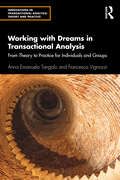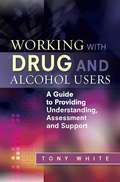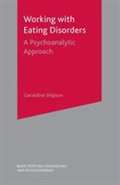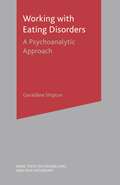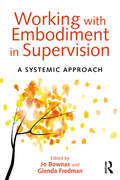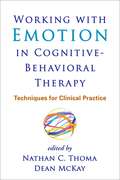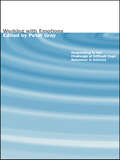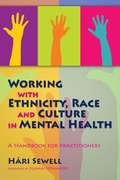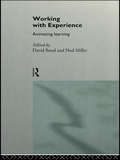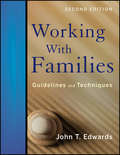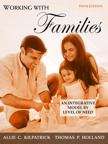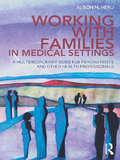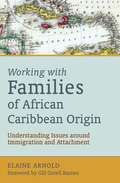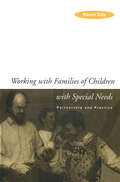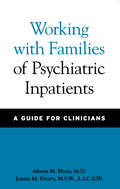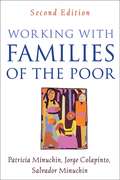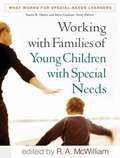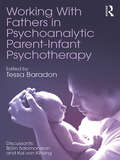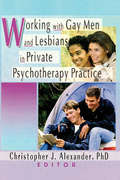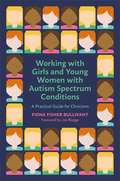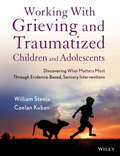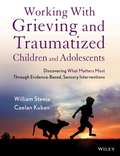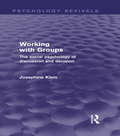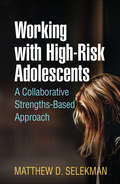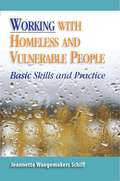- Table View
- List View
Working with Dreams in Transactional Analysis: From Theory to Practice for Individuals and Groups (Innovations in Transactional Analysis: Theory and Practice)
by Anna Emanuela Tangolo Francesca VignozziThis unique book, incorporating both theory and practice, provides an invaluable guide to the assessment of dreams in transactional analysis (TA).Grounded in the latest neuroscientific research, it offers both neophyte and experienced TA practitioners a pathway to incorporate a client’s dreams within individual and group therapy, exploring key issues including trauma, dissociation and nightmares, dreams of change and transformation, dreams of healing, and transference and countertransference in dreams.It will support therapists through the very first steps toward the analysis of more complex interpersonal dynamics and dream analysis in a group setting. Also discussing the direction of future research in the area, as well as an overview of an experiment on dream analysis during the recent pandemic, this will be key reading for anyone working in the field.
Working with Drug and Alcohol Users: A Guide to Providing Understanding, Assessment and Support
by Tony WhiteWorking with Drug and Alcohol Users provides an accessible guide to substance use and working with substance users. Using transactional analysis theory, the author explains why some people use substances, exploring different personality types, and covers the basic components of drug counseling. The book then outlines different counseling techniques used to treat and manage substance users, using transactional analysis models. These include motivational interviewing, harm reduction counseling, drug use ambivalence work and relapse process work. A chapter on teenage drug users is also included. Case examples feature throughout to demonstrate the ideas in practice. This will be an essential guide for all those working with drug and alcohol users, including counselors, psychotherapists, psychologists and support workers.
Working with Eating Disorders: A Psychoanalytic Approach
by Geraldine ShiptonEating disorders such as anorexia and bulimia are increasingly prevalent in today's society and of great concern to a wide range of health-related professionals, including counsellors and psychotherapists. This important new text, written in an intelligent yet accessible style, provides an authoritative and practical introduction to therapeutic work with this large client group. Taking a psychodynamic approach, Working with Eating Disorders also embraces an appreciation of cultural influences and uniquely illustrates the context of eating disorders in today's society.
Working With Eating Disorders: A Psychoanalytic Approach (Basic Texts in Counselling and Psychotherapy)
by Geraldine ShiptonEating disorders such as anorexia and bulimia are increasingly prevalent in today's society and of great concern to a wide range of health-related professionals, including counsellors and psychotherapists. This important new text, written in an intelligent yet accessible style, provides an authoritative and practical introduction to therapeutic work with this large client group. Taking a psychodynamic approach, Working with Eating Disorders also embraces an appreciation of cultural influences and uniquely illustrates the context of eating disorders in today's society.
Working with Embodiment in Supervision: A systemic approach
by Jo Bownas Glenda FredmanWorking with Embodiment in Supervision: A Systemic Approach offers a number of approaches to working with the body in therapy and counselling supervision. The authors are all experienced supervisors of clinical practice. The book is divided into two parts. Part One addresses how power and difference are embodied, exploring implications for the supervisory process. Part Two offers supervisees and supervisors practices for using our bodies with intention in supervision, working with physical sensation, emotion and bodily movement and expression. The book introduces a repertoire of innovative practices for supervisors to reflect on, talk about and work with embodiment in supervisory practice and includes exercises and detailed guides to assist readers in using the practices in their own work. Working with Embodiment in Supervision will be of use for practitioners (both supervisors and supervisees) involved in supervision of clinical practice, as well as trainers and trainees engaged in supervision training. It should also be of interest to those who want to address embodiment in mental health, psychology, psychotherapy and counselling practice.
Working with Emotion in Cognitive-Behavioral Therapy
by Nathan C. Thoma Dean MckayWorking actively with emotion has been empirically shown to be of central importance in psychotherapy, yet has been underemphasized in much of the writing on cognitive-behavioral therapy (CBT). This state-of-the-art volume brings together leading authorities to describe ways to work with emotion to enrich therapy and achieve more robust outcomes that go beyond symptom reduction. Highlighting experiential techniques that are grounded in evidence, the book demonstrates clinical applications with vivid case material. Coverage includes mindfulness- and acceptance-based strategies, compassion-focused techniques, new variations on exposure-based interventions, the use of imagery to rework underlying schemas, and methods for addressing emotional aspects of the therapeutic relationship.
Working with Emotions: Responding to the Challenge of Difficult Pupil Behaviour in Schools
by Peter GrayDifficult pupil behaviour presents a number of issues for teachers, parents, other pupils as well as for children themselves. Inevitably it raises a number of emotions and challenges people's sense of their own personal effectiveness.This edited collection of short, concise chapters provides advice and guidance to professionals on how to respond to the emotions experienced and generated by pupils with behavioural difficulties in schools. Many chapters are written by such professionals themselves and address common problems in a practical and accessible way. Working with Emotions is an essential text for all schools, support services, LEAs, SENCOs and voluntary agencies and includes discussions on the government's current Social Inclusion initiative.
Working with Ethnicity, Race and Culture in Mental Health: A Handbook for Practitioners
by Hári Sewell Suman FernandoThis book enables front line practitioners to understand why it is important to consider the specific needs of people from black and minority ethnic (BME) backgrounds in mental health settings. It offers practical guidance on how practitioners can take positive steps to improve the quality of their work and their relationships with BME service users, and ultimately how to improve their outcomes. By advocating the practice of recognizing the individuality of each service user, this book provides practitioners with the tools and information they need to work fairly and effectively. Case examples of organisations that have achieved a quality of delivery that is valued by BME people are included, along with exercises that help practitioners to make links between theory and their individual practice. It is invaluable reading for all those working on the front line in mental health.
Working with Experience: Animating Learning
by David Boud Nod MillerEvery day we are confronted with problems and challenges which we address by drawing on our experience and by using this experience to find ways of learning what to do in new circumstances. Learning through experience is the normal, commonplace approach to learning and we take it for granted. Whilst much is known about teaching and being taught, far less attention has been given to learning in context - in particular, to learning outside the classroom. Yet this is in fact where most learning takes place. One possibly neglected area is the role which people, other than the learner, play in facilitating learning. This role is undertaken not only by teachers, trainers, parents and counsellors, but also by managers, supervisors, care-givers and friends. This book brings together the experiences of a number of practitioners, who write from often strongly contrasting perspectives. Such perspectives include feminism, Marxism, critical pedagogy, post-modernism and Gestalt, humanistic, clinical and transpersonal psychology.
Working With Families: Guidelines and Techniques
by John T. EdwardsA complete guide for helping professionals, with tried-and-true techniques for practicing family counseling therapyNow in its second edition, Working With Families: Guidelines and Techniques is filled with up-to-date, systems-oriented techniques focused on field-tested results. Outlining the dos and don'ts of working with different types of families and the various complications, nuances, and complexities that can occur, this practical guide provides a broad and proven selection of interventions, processes, and guidelines for working interactively, systematically, and compassionately with families.Working With Families, Second Edition covers a range of topics including:Family work in different settingsSession-by-session guidelinesTherapeutic themes by family typeManaging adolescents in family sessionsDealing with fear of family workFamily mappingStrategic child assessmentChemical dependence and its impact on familiesInformed by the author's many years of experience in the field, both as a clinician and as a trainer, Working With Families, Second Edition offers an invaluable systems-oriented, goal-directed, problem-solving approach to family counseling therapy for all mental health professionals.
Working With Families: An Integrative Model By Level Of Need (Fifth Edition)
by Allie C. Kilpatrick Thomas P. HollandThis text focuses on all levels of need within a family, and provides clear guidelines for effective family interventions. The authors emphasize family strengths, coping capacities, and the many commonalities shared by all. All levels of need are addressed and practice models are applied, highlighting the importance of looking at the specific needs of each family and the effective practice interventions.
Working With Families in Medical Settings: A Multidisciplinary Guide for Psychiatrists and Other Health Professionals
by Alison M. HeruWorking With Families in Medical Settings provides mental-health professionals with the tools they need to figure out what patients and families want and how, within the constraints imposed by 21st-century healthcare setting, to best give them the care they need. Psychiatrists and other clinicians who work in medical settings know that working with a patient with a chronic illness usually entails work with that patient’s family as well as with other medical professionals. Some families need education; others have specific difficulties or dysfunctions that require skilled assessment and intervention. It is up to the clinician to find productive ways to work with common themes in family life: expressed emotion, levels of resilience, life-cycle issues, and adaptation to illness, among others. Enter Working With Families in Medical Settings, which shines a spotlight on the major issues professional caregivers face and shows them how to structure an effective intervention in all kinds of settings. Psychiatrists, particularly those in psychosomatic medicine, and other clinicians who work with the medically ill will find Working With Families in Medical Settings to be an essential resource and guide to productive relationships with patients and their families.
Working with Families of African Caribbean Origin: Understanding Issues around Immigration and Attachment
by Gill Gorell Barnes Elaine ArnoldMany of those who emigrated from the Caribbean to the UK after World War II left behind partners and children, causing the break-up of families who were often not reunited for several years. In this book, Elaine Arnold examines the psychological impact that immigration had on these families, in particular with relation to attachment issues. She demonstrates that the disruption caused by separation from both family and country often had long-term traumatic consequences. The book draws on two studies carried out by the author in 1975 and 2001. In the first, she interviewed mothers who had emigrated without their children, and in the second, children (now adults) who had been left behind and were later reunited with their parents. This insightful book will assist all those working with people of African Caribbean origin in the UK to better understand their experiences and the impact that separation and loss has had on their lives. It is essential reading for social workers, counsellors, therapists and any other professionals working with families of African Caribbean origin.
Working with Families of Children with Special Needs: Partnership and Practice
by Naomi DaleThe importance of partnerships between professionals and the parents of children with special needs/disability is well established in childcare legislation. But is it reflected in practice?Written for practitioners and those in training, this book recognises that forming partnerships can be a fraught process involving dissent as well as cooperation. Naomi Dale draws on case histories from her own experience to examine key partnership issues such as consent, confidentiality and diagnosis delivery. She combines up-to-date theory and research with practice to provide a wealth of suggestions and ideas for effective family work.Working with Families of Children with Special Needs features useful exercises with each chapter, making it an excellent resource book and practice manual for multidisciplinary professionals.
Working with Families of Psychiatric Inpatients: A Guide for Clinicians
by Alison M. Heru Laura M. DruryWorking with the families of inpatients is one of the most important—and most challenging—aspects of practicing clinical psychiatry. Clinicians are responsible not only for the well-being of their patients but also for the education and guidance of the patient’s family. In this book, Alison M. Heru and Laura M. Drury offer a step-by-step guide to developing the skills needed to work successfully with patients’ families. Research data, outlined in the opening chapters, demonstrate just how essential families and evidence-based family treatment are to effective patient care. Succeeding chapters use clinical case studies to illustrate the skills necessary for the assessment and treatment of the family. Psychiatric residents will enhance their knowledge of the family as a part of the patient’s social context and learn how to conduct a family meeting, common mistakes to avoid, and when to refer the family for other assistance. The authors also describe specific strategies for intervening with difficult families and for overcoming some of the fears and anxieties common among residents when they interact with patients’ families.The authors provide valuable insights into the perspectives of families and patients and offer practical suggestions for risk management after the patient is discharged from inpatient care. Keyed to the requirements articulated by the American College of Graduate Medical Education, this handbook is a tool no psychiatric resident can do without.
Working with Families of the Poor, Second Edition
by Patricia Minuchin Jorge Colapinto Salvador MinuchinNow in a substantially revised second edition, this widely adopted text and practical guidebook presents the fundamentals of family-based intervention with clients struggling with chronic poverty-related crises and life stressors. Grounded in Salvador Minuchin's influential systemic model and the extensive experience of all three highly regarded authors, the book illustrates innovative ways for professionals within substance abuse, foster care, and mental health contexts to build collaboration with families and other helpers, and to elicit families' strengths. The second edition features many new case examples and includes discussions of exemplary programs. It also gives increased attention to key factors that make agencies effective and enable them to maintain a family focus over time.
Working with Families of Young Children with Special Needs
by R. McwilliamThis user-friendly book presents research-based best practices for serving families of children with special needs from birth to age 6. Expert contributors demonstrate how early intervention and early childhood special education can effectively address a wide range of family concerns, which in turn optimizes children's development and learning. Tightly edited, the volume offers indispensable tools for assessing families; identifying and capitalizing on their strengths; providing information, support, and coaching; collaborating with parents and teachers to address children's functional needs in the context of everyday routines; and coordinating care. Over a dozen reproducible checklists and forms help professionals immediately implement the techniques and strategies described.
Working With Fathers in Psychoanalytic Parent-Infant Psychotherapy
by Tessa BaradonWorking With Fathers in Psychoanalytic Parent-Infant Psychotherapy interfaces theoretical ideas about fatherhood and their incorporation into the clinical practice of psychoanalytic parent-infant psychotherapy. Often, when a family attends parent-infant psychotherapy, issues of the father are eclipsed by attention to the mother, who is usually the identified patient. Until now relatively neglected in the literature, this book attends to both the barriers to psychological work with the father, and to ways in which he can be engaged in a therapeutic process. In this book, Tessa Baradon brings together some of the most eminent clinicians and academics in the field of parent-infant psychotherapy, in a layered collection of theoretical and clinical contributions. She and her co-discussants, Björn Salomonsson and Kai von Klitzing, conclude with an integration and critique of the themes presented, exploring the ideas of their fellow contributors and expanding on the central themes of the work. Working With Fathers in Psychoanalytic Parent-Infant Psychotherapy will be of interest to mental health practitioners working with infants, who will learn that each individual and the family as a system can benefit from such an inclusive approach.
Working with Gay Men and Lesbians in Private Psychotherapy Practice
by Christopher J AlexanderWorking with Gay Men and Lesbians in Private Psychotherapy Practice is written for private practitioners solely by private practice clinicians who specialize in the treatment of gay men or lesbians. Focusing on numerous clinical issues that gays and lesbians often deal with, Working with Gay Men and Lesbians in Private Psychotherapy Practice also offers you proven guidance for maintaining and promoting your psychotherapy practice as a business.You will explore issues such as whether the therapist should disclose her/his sexual orientation, and how the therapist should address the degree to which internalized stigma about sexual orientation may impact the client’s concerns about the process of therapy in general. This insightful volume also focuses on the special complexities introduced to psychotherapy by managed care. You’ll find detailed, practical information about: a strategic plan for establishing, marketing, and developing a private practice in l/g/b psychology staying abreast of the latest research and trends in gay/lesbian mental health treatment planning with gay and lesbian clients lesbian/gay couples counseling multiple identity and gender issues particular to culture and ethnicity boundary issues Working with Gay Men and Lesbians in Private Psychotherapy Practice tackles how to therapeutically respond to the issues of gay men and lesbians. The practical strategies and specific suggestions can be directly incorporated into your work with gay and lesbian clients to ensure your success in confronting the specific issues and challenges they face.
Working with Girls and Young Women with an Autism Spectrum Condition: A Practical Guide for Clinicians
by Fiona Fisher BullivantThis guide shows how clinicians can help girls and young women with ASC to reach their full potential, by adopting more relationship-based, individualised approaches. With contributions from young women about their experiences in clinical settings, the book reflects on what clinicians have done right and wrong to date, why girls and women with ASC are too often misunderstood, and how the culture of how clinicians work with them needs to change in order to achieve better results. In a concise and practical way, it covers how to better understand clients' needs and foster strong relationships through diagnosis, understanding comorbidities, sensory issues, self-harm, emotional regulation, assessments, interventions and strategies.
Working with Grieving and Traumatized Children and Adolescents
by Caelan Kuban William SteeleA structured, sequential, and evidence-based approach for the treatment of children and adolescents experiencing trauma or grief. Working With Grieving and Traumatized Children and Adolescents features the Structured Sensory Interventions for Traumatized Children, Adolescents and Parents (SITCAP) intervention model, proven in successfully addressing violent situations such as murder, domestic violence, and physical abuse, as well as non-violent grief- and trauma-inducing situations including divorce, critical injuries, car fatalities, terminal illness, and environmental disasters.Filled with practical and proven activities for use with children and adolescents experiencing trauma and grief, this resource is based on the authors' experience working with all types of traumatic events in school-, agency-, and community-based programs across the country.
Working with Grieving and Traumatized Children and Adolescents
by William Steele Caelan KubanThis book provides a structured, sequential, and evidence-based approach for treating children and adolescents who are experiencing trauma or grief. This approach can be used for all types of traumatic events and is suitable for both experienced and novice mental health professionals. Two of the interventions presented in the book-SITCAP-ART and I Feel Better Now-have proven useful in multiple settings with diverse cultures. This book reflects a resilience perspective and explores the factors that lead to and support resilience and recovery. Accessible and practical, this useful guide is filled with all the activities needed for individual sessions--packaged in an easily reproducible format.
Working with Groups: The Social Psychology of Discussion and Decision (Psychology Revivals)
by Josephine KleinOriginally published in 1963, this book was one of the first to explore group process and working with groups. The introductory chapter tells us that working with groups requires three skills: and understanding of theory, a knowledge of its application, and trained experience in its use. It goes on to discuss these points, helping the reader towards an understanding of group processes and making decisions in groups. This title is an early example of author’s explorations of groups and group work, which were to be a major factor in the establishment of group-work practice in Britain over the following years.
Working with High-Risk Adolescents: An Individualized Family Therapy Approach
by Matthew D. Selekman Harlene AndersonThis innovative book focuses on helping high-risk adolescents and their families rapidly resolve long-standing difficulties. Matthew D. Selekman spells out a range of solution-focused strategies and other techniques, illustrating their implementation with vivid case examples. His approach augments individual and family sessions with collaborative meetings that enlist the strengths of the adolescent's social network and key helping professionals from larger systems. User-friendly features include checklists, sample questions to aid in relationship building and goal setting, and reproducible forms that can be downloaded and printed in a convenient 8 1/2" x 11" size. Blending family therapy science with therapeutic artistry, the book significantly refines and updates the approach originally presented in Selekman's Pathways to Change.
Working with Homeless and Vulnerable People: Basic Skills and Practices
by Jeannette Waegemakers SchiffIt has long been established that access to food, clothing, medical care, and housing are fundamental human rights the world over. Helping the approximately 600,000 Americans and 300,000 Canadians who are currently homeless work toward this goal is a complex undertaking. This text presents the fundamental knowledge and skills that frontline workers need in order to help vulnerable and homeless persons. It provides readers with both an understanding of the lived experiences of those who have faced homelessness and an outline of the interprofessional practice context of services for homeless people. Waegemakers Schiff focuses on the interventions and best practices that have been found to be most effective in making connections, establishing helping relationships, and working with individuals on moving toward stabilization.
